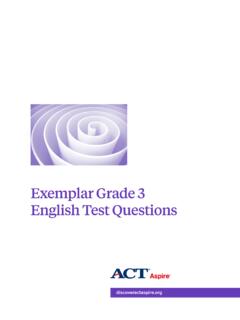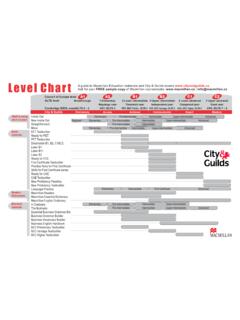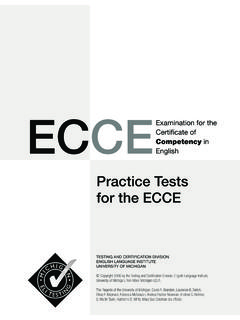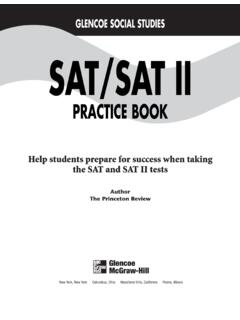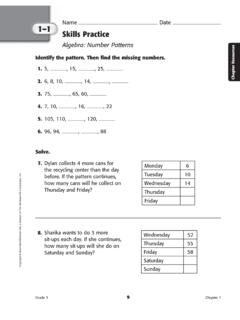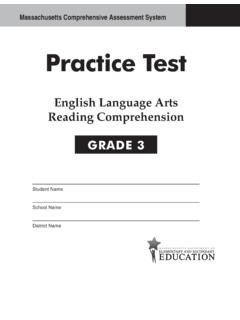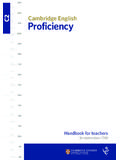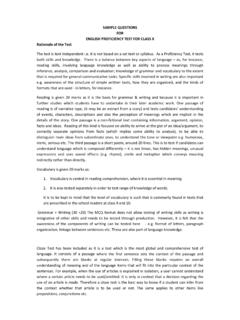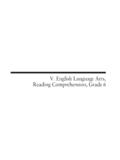Transcription of Exemplar Grade 7 English Test Questions - Pearson
1 Exemplar Grade 7 English Test 2015 by ACT, Inc. All rights reserved. ACT Aspire is a registered trademark of ACT, Inc. 40441 IntroductIonIntroductionThis booklet explains ACT Aspire Grade 7 English test Questions by presenting, with their answer keys, sample Questions aligned to each reporting category on the test. A key includes the question s depth-of-knowledge (DOK) level,1 an explanation of the task posed by each question , a thorough explanation of correct responses, ideas for improvement, and more. The Exemplar test Questions included here are representative of the range of content and types of Questions found on the ACT Aspire Grade 7 English test. Educators can use this resource in several ways: Become familiar with ACT Aspire question types. See what typical Questions in each ACT Aspire reporting category look like. Help reinforce or adjust teaching and learning objectives. Learn how ACT Aspire improvement idea statements can help students identify key skills they have not yet CategoriesACT Aspire English tests assess students developed ability to revise and edit texts.
2 A typical English test contains several stimuli, or texts, and a series of selected-response (multiple-choice) and technology-enhanced Questions . Texts used in the assessments represent various content areas (including English language arts, the humanities, and the social and natural sciences), and, considered collectively, reflect a range of text complexity levels from simple to complex, as appropriate for students age and educational attainment. The Questions fall under the following reporting of Standard EnglishThe Questions in this category require students to apply an understanding of the conventions of standard English grammar, usage, and mechanics to revise and edit and Usage ConventionsThese Questions require students to edit text to conform to standard English punctuation and Norman L. Webb, Depth-of-Knowledge Levels for Four Content Areas, last modified March 28, 2002, Structure and FormationThese Questions test understanding of relationships between and among clauses, placement of modifiers, and shifts in of WritingThe Questions in this category require students to apply an understanding of the rhetorical purpose and the focus of a piece of writing to develop a topic effectively and to use various strategies to achieve logical organization, topical unity, and general DevelopmentThese Questions require students to demonstrate an understanding of and control over the rhetorical aspects of texts by identifying the purpose of parts of texts, determining whether a text has met its intended goal, and evaluating the relevance of material in terms of a text s , Unity, and CohesionThese Questions require students to use various strategies to ensure that text is logically organized, flows smoothly.
3 And has an effective introduction and of LanguageThese Questions require students to demonstrate effective language use through ensuring precision and concision in word choice and maintaining consistency in style and IdeasACT Aspire includes simple improvement ideas at the reporting category (skill) level on student and parent reports. These improvement ideas are provided for the lowest performing skill for each subject tested. The skills are always ordered from highest performing to lowest performing based on the percentage of points correct. If the percentages for two or more skills are tied, the skill with the lower number of total points is displayed first. Keep in mind that the order of skills listed on reports may not always be exemplary of where to focus learning. For example, the skills in which a student performed within the ACT Readiness Range may not always be listed first, and the skills in which a student did not perform within the ACT Readiness Range may not always be listed last.
4 Also, keep in mind the total number of points possible in each skill when interpreting the percentage are two levels of improvement idea statements (low and high) for ACT Aspire summative reporting. Low statements are given on the report if the student s lowest skill score is below the ACT Readiness Range for that particular skill. High statements are given on the report if the student s lowest skill score is at or above the ACT Readiness Range for that particular KEyAnswer KeyThis section presents a stimulus text and the sequence number, Grade , question type, DOK level, alignment to the ACT Aspire reporting categories, and correct response for each question about the text. Each question is accompanied by an explanation of the question and the correct response as well as improvement idea statements for ACT Aspire : The Computer Age of Comic Book Art The Computer Age of Comic Book ArtAs recently as twenty years ago, most comicbook artists were still working with the original tools oftheir trade: pencil, pen, and paper.
5 For decades, theprocess for creating comic book art had remainedfairly simple. First, an artist drew the comic book spanels (the individual drawings that, taken together,tell the comic book s story)using pencil. Then thepenciled panels were traced over fromthe artist usingink. Finally, color was applied to the panels. Theresulting artwork was often crude the penciled lineswere indistinct, the ink got smudged, and the colorsappeared , however, most comic book artists haveentered the brave new world of digital technology. Anartist can now scan her penciled panels directly into acomputer, where they can be improved by the artistwith digital tools. For example, using graphic designsoftware, an artist can make the lines in panelsappear crisper. The artist can also add digitalshadows to the characters, making them seem more realistic by adding digital shadows to artist can even switch the artwork from full color to black-and-white with a single touch of a digital tools have led many artists to stopusing pencils and paper altogether.
6 On tabletcomputers, an artist can use a stylus to draw herpanels on the tablet s screen. The artist can then savethe panels as digital files. The advantage of doing sois twofold. First, an artist can easily create differentversions of the same panels, so later on she candecide which version she likes best. Secondly, if theartist makes a mistake in one of her panels, she cansimply undo the mistake on her tablet. With penciland paper, this wouldn t be possible, and a singleerasure mark on a superhero s bulging biceps canruin an entire panel, forcing the artist to start overfrom KEyQuestion 1 SequenceGrade question typedoK levelreporting categorycorrect response17 Selected Response3 Production of WritingDThis selected-response question requires students to determine the main rhetorical contribution a particular phrase makes to a text (aligns with the Common Core State Standards College and Career Readiness anchor standards [CCRA] , ). To answer the question , students must read the entire sentence carefully and select the answer option that best identifies what would be lost if the highlighted portion were ResponseOf the available answer options, answer option D is the most precise option and the only one that correctly identifies the rhetorical purpose of the highlighted parenthetical phrase as providing a definition of comic panels.
7 Answer option A is incorrect because the highlighted text does not provide information about the size of comic panels. Answer option B is incorrect because the highlighted portion is a fact and contains no qualitative information about the popularity of comics. Answer option C is incorrect because the highlighted text is neither a critique nor specific to a particular artist. Improvement Idea Statementsreporting categoryGradeLow statement (scored below Act readiness range)High statement (scored at or above Act readiness range)Production of Writing7In your writing, work on developing your topic effectively, organizing your ideas logically, and expressing your ideas in a clear and consistent writing for a variety of purposes. Continue working on organizing ideas in logical, cohesive ways and on expressing ideas in a precise, concise, and stylistically consistent KEyQuestion 2 SequenceGrade question typedoK levelreporting categorycorrect response27 Selected Response1 Conventions of Standard EnglishBThis selected-response question requires students to identify and correct language that does not conform to conventional ways of expressing ideas in standard English (aligns with , ).
8 After reading the sentence carefully, students must identify the highlighted word as an idiomatically incorrect use of a preposition. Students must then select an answer option that conforms to the conventions of standard English ResponseAnswer option B is the best option because the preposition by is idiomatically appropriate here; answer option B also creates a logical relationship between the panels and the artist. All other answer options are idiomatically Idea Statementsreporting categoryGradeLow statement (scored below Act readiness range)High statement (scored at or above Act readiness range)Conventions of Standard English7 Work on using parts of speech and punctuation (including punctuating essential/nonessential elements). Avoid sentence structure errors, such as misplaced modifiers and inappropriate shifts in verb yourself to write increasingly complex sentences, avoiding errors in sentence construction. Work on correctly using parts of speech and punctuation (including colons, semicolons, and dashes) KEyQuestion 3 SequenceGrade question typedoK levelreporting categorycorrect response37 Selected Response3 Knowledge of LanguageDThis selected-response question requires students to recognize and revise instances of redundancy in text (aligns with 5, ).
9 Students must read the entire sentence carefully, identify the redundancy in the highlighted portion, and select the answer option that eliminates this ResponseAnswer option D is the only choice that does not unnecessarily repeat information provided elsewhere in the sentence. It also eliminates Idea Statementsreporting categoryGradeLow statement (scored below Act readiness range)High statement (scored at or above Act readiness range)Knowledge of Language7In your writing, work on choosing language that is clear and precise, especially avoiding unnecessary wordiness and redundancy. Also focus on maintaining consistency in style and your writing, continue working on choosing language that is precise and concise. Be sure to maintain consistency in style and tone.
